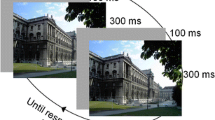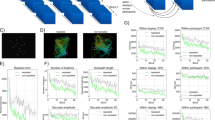Abstract
Two experiments were designed to compare scene recognition reaction time (RT) and accuracy patterns following observer versus scene movement. In Experiment 1, participants memorized a scene from a single perspective. Then, either the scene was rotated or the participants moved (0°–360° in 36° increments) around the scene, and participants judged whether the objects’ positions had changed. Regardless of whether the scene was rotated or the observer moved, RT increased with greater angular distance between judged and encoded views. In Experiment 2, we varied the delay (0, 6, or 12 s) between scene encoding and locomotion. Regardless of the delay, however, accuracy decreased and RT increased with angular distance. Thus, our data show that observer movement does not necessarily update representations of spatial layouts and raise questions about the effects of duration limitations and encoding points of view on the automatic spatial updating of representations of scenes.




Similar content being viewed by others
References
Avraamides, M. N. (2003). Spatial updating of environments described in texts. Cognitive Psychology, 47, 402–431.
Christou, C. G., & Buelthoff, H. H. (1999). View dependence in scene recognition after active learning. Memory & Cognition, 27, 996–1007.
Diwadkar, V. A., & McNamara, T. P. (1997). Viewpoint dependence in scene recognition. Psychological Science, 8, 302–307.
Farrell, M. J., & Robertson, I. H. (1998). Mental rotation and automatic updating of body-centered spatial relationships. Journal of Experimental Psychology: Learning, Memory, & Cognition, 24, 227–233.
Farrell, M. J., & Thomson, J. A. (1998). Autonomic spatial updating during locomotion without vision. Quarterly Journal of Experimental Psychology: Human Experimental Psychology, 51A, 637–654.
Luck, S., & Vogel, E. K. (1997). The capacity of visual working memory for features and conjunctions. Nature, 390, 279–281.
Motes, M. A., Finlay, C. A., & Kozhevnikov, M. (in press). Scene movement versus observer movement in scene recognition: A test of the spatial updating hypothesis. Perception.
Motes, M. A., Finlay, C. A., & Kozhevnikov, M. (2006). Effects of set-size on scene recognition following locomotion. Presented at the Vision Sciences Society Annual Meeting.
Mou, W., & McNamara, T. P. (2002). Intrinsic frames of reference in spatial memory. Journal of Experimental Psychology: Learning, Memory, & Cognition, 28, 162–170.
Mou, W., McNamara, T. P., Valiquette, C. M., & Rump, B. (2004). Allocentric and egocentric updating of spatial memories. Journal of Experimental Psychology: Learning, Memory, & Cognition, 30, 142–157.
Rieser, J. J. (1989). Access to knowledge of spatial structure at novel points of observation. Journal of Experimental Psychology: Learning, Memory, & Cognition, 15, 1157–1165.
Shelton, A. L., & McNamara, T. P. (2004). Orientation and perspective dependence in route and survey learning. Journal of Experimental Psychology: Learning, Memory, & Cognition, 30, 158–170.
Simons, D. J., & Wang, R. F. (1998). Perceiving real-world viewpoint changes. Psychological Science, 9, 315–320.
Waller, D., Montello, D. R., Richardson, A. E., & Hegarty, M. (2002). Orientation specificity and spatial updating of memories for layouts. Journal of Experimental Psychology: Learning, Memory, & Cognition, 28, 1051–1063.
Wang, R. F., & Simons, D. J. (1999). Active and passive scene recognition across views. Cognition, 70, 191–210.
Wang, R. F., & Spelke, E. S. (2000). Updating egocentric representations in human navigation. Cognition, 77, 215–250.
Author information
Authors and Affiliations
Corresponding author
Rights and permissions
About this article
Cite this article
Finlay, C.A., Motes, M.A. & Kozhevnikov, M. Updating representations of learned scenes. Psychological Research 71, 265–276 (2007). https://doi.org/10.1007/s00426-006-0082-2
Received:
Accepted:
Published:
Issue Date:
DOI: https://doi.org/10.1007/s00426-006-0082-2




